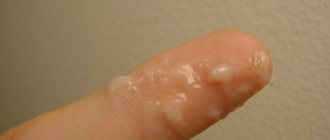Causes
Prolapse of the vaginal walls is caused by stretching of the ligaments that hold the internal organs and their subsequent pressure on the perineum. All this is enhanced by dysfunction of the smooth muscles of the vagina and its strong stretching, as well as weak tone of the pelvic floor muscles.
As a result, the back or front wall, or both at once, shifts under the pressure of the uterus, bladder or intestines and can fall beyond the genital slit. In most cases, prolapse of the walls is accompanied by uterine prolapse (its displacement, partial or complete exit beyond the genital slit).
Often the disease is a consequence of the following phenomena:
- the birth of a large child;
- traumatic or difficult childbirth;
- multiple or prolonged labor;
- removal of the uterus without simultaneous fixation of the vaginal dome;
- obesity;
- connective tissue diseases, dysplasia;
- chronic cough.
Unfortunately, no woman can be one hundred percent safe and be sure that this illness will not affect her personally.
Types of pathology
Modern gynecology defines two main types of prolapse and prolapse of the vaginal walls in women, namely cystocele (prolapse or prolapse of the anterior wall) and rectocele (pathology of the posterior wall), as well as three main degrees of development of the disease.
Prolapse of the anterior vaginal wall
Cystocele is characterized by drooping or prolapse of the anterior wall and prolapse of the bladder, which puts pressure on the weakened muscular septum and vaginal wall and squeezes it out until it completely falls out of the genital slit.
All this occurs due to weakness of the intimate muscles, as well as rupture or severe sprain of the ligaments that hold the bladder in its anatomical position.
In the early stages, cystocele is usually discovered during intense physical activity or a routine examination by a gynecologist. In more advanced cases, women feel as if there is a foreign body inside the vagina, experience dryness or burning in this area, and by touch during washing they identify it as something sticking out of the vagina.
It is not uncommon for a tumor to appear on the walls of the vagina, one of which is called a vaginal cyst - this is a tumor-like formation on the vaginal wall, which increases due to the accumulation of fluid in its cavity. Attention! If you notice the appearance of milk in your breasts for no apparent reason, this is a clear hormonal imbalance in the body, read the link...
In most cases, prolapse of the anterior wall is accompanied by partial urinary incontinence, especially during physical activity, as well as prolapse of the bladder. In this case, the bladder does not empty completely; urine stagnates in it, which easily becomes a breeding ground for infectious pathogens. Therefore, cystocele is also fraught with cystitis.
Prolapse of the posterior vaginal wall
Rectocele occurs when the functions of the pelvic floor muscles of the posterior vault are impaired, and the endopelvic fascia is almost always disrupted or destroyed. The degree of development of the disease depends on the degree of failure of the latter.
Weakening of the muscles leads to prolapse of the vaginal walls
With a rectocele, a woman also feels a foreign body in the vagina, which interferes with walking and sitting. Unpleasant sensations are accompanied by problematic stools. A kind of pocket is formed in the rectum, in which a large amount of feces accumulates. Therefore, in order to empty the intestines, the patient has to push hard, and in advanced cases of rectocele, even help the intestines to empty with a finger.
Complications after antibiotics in the anus
Unpleasant, itchy sensations in the anus can be caused not only by helminthiasis, but also by taking antibiotics. Itching in the anus after antibiotics is no less unpleasant than itching in intimate places. The reason for this itching is dysbacteriosis. The direct process of dysbacteriosis does not occur in the anus. Typically, dysbiosis covers the entire intestine and is a systemic digestive disorder. But if intestinal dysbiosis may not manifest itself, then in the anus this symptom will bring a lot of inconvenience - irritation of the skin near the anus, there may be itching in the urethra. If dysbiosis is present in women, it is almost always complicated by vaginal symptoms. The patients' anus itches, patients have difficulty sleeping at night, since the burning sensation in the intimate area does not give rest.
Read more Eco by cycle day
Most often, itching in the perineum and anus is caused by cephalosporins, tetracyclines, macrolides and fluoroquinolones. Itching is complicated by other unpleasant symptoms - diarrhea and flatulence may appear. It is more difficult to cure such consequences of taking antibiotics, since it is important not only to eliminate the itching itself, but also to normalize digestion.
If the disease is not treated: consequences
In the initial stages, the disease causes virtually no discomfort. Developing further, it begins to disrupt a woman’s quality of life. However, most of them do not consider it necessary to consult a doctor for help and gradually get used to living with it. But this is fraught with a lot of complications:
Due to the bending of the ureters in the residual urine, infections can develop that lead to cystitis and pyelonephritis.
Prolapse of the vaginal walls is accompanied by displacement of the pelvic organs and disruption of their functions. As a result, patients suffer from constant constipation and urinary incontinence.
The vaginal walls and uterus falling outside the genital slit can easily be injured, for example, from friction with underwear. In addition, their significant displacement may be accompanied by circulatory disorders. Subsequently, the tissues may swell and even die.
If the disease is completely neglected, it will most likely lead to complete prolapse and inversion of the uterus with all that it entails: infections, ulcers, and others.
In addition, untreated pathology is a serious obstacle to normal pregnancy and successful childbirth. For example, the disease of the second and third stages is fraught with spontaneous abortion. An illness at any stage can cause rapid labor, which is dangerous for the mother due to severe ruptures and bleeding, while the child simply does not have time to adapt to the new environment.
Postpartum weakness and stretching of the birth canal, supported by genital prolapse, are the reason for the prolongation of the postpartum period, which not only causes some inconvenience, but is also fraught with infection of the genital organs.
Vaginal itching after taking antibiotics
Long-term therapy with antibacterial drugs can lead to a number of unpleasant complications. The most common are: disruption of the normal intestinal microflora and vaginal microbiota.
Livarol ®
A quick effect is achieved by using Livarol ® (an antimycotic with the active ingredient ketonazole), administered intravaginally, in the form of suppositories, once a day, for a course of 3-5 days.
Contraindicated in the first trimester of pregnancy!
Lactagel ®
To prevent disruption of the normal vaginal microflora during a course of antibiotics.
The active components of the drug are lactic acid and glycogen, which restore the vaginal pH, eliminate unpleasant odor and reduce the amount of discharge.
Approved for use during lactation and pregnancy.
To eliminate the symptoms of bacterial vaginosis, use one tube of gel for seven days, before bed.
For preventive purposes, it is recommended to use it twice a week.
Not prescribed during the active period of thrush.
Clindamycin ®
For mild to moderate severity of the disease, it is used for topical application in the form of a 2% gel, once a day. in a week.
The administration of this drug in the form of a vaginal cream is permissible in the second and third trimesters of pregnancy, due to the lack of data on its teratogenic effect. In the first trimester, the use of clindamycin ® is possible only for absolute indications.
The drug is oil-based and may reduce the strength of latex condoms and diaphragms.
The use of Dalatsin ® (clindamycin ovuli ® , in the form of vaginal suppositories) 100 mg for three days is also effective.
For oral administration, 300 mg is prescribed twice a day for up to seven days.
Treatment of vaginal wall prolapse
There are three radically different treatment methods. Treatment almost always begins with physical therapy, which can give excellent results and completely cure the patient. If physical education and mass exercise do not help, the doctor recommends restoring the physiological location of the pelvic organs surgically. If surgery is not possible, the pathology is eliminated by installing pessaries.
Intimate gymnastics: Kegel exercises
The set of exercises was developed by an American gynecologist about half a century ago. Having reached this day, it has changed slightly, but the essence of the exercises remains the same.
The convenience of the complex lies in the fact that the training is absolutely invisible to others, so you can practice literally anywhere and almost always.
The convenience of the complex lies in the fact that the training is completely invisible to others
At home, exercises can be performed without a simulator, but training under the supervision of a specialist and using simulators gives much more significant results. Exercises should be done in stages.
Stage one: slow compressions
You need to tense the muscles that are used to stop urination slowly, first on a count of 3, then relax the muscles for three seconds. Over time, it is necessary to keep the muscles in a tense position, increasing this time to 20–30 seconds.
Stage two: dynamic contractions
The same muscles need to be tensed and relaxed as quickly as possible. Start with 20 repetitions, gradually increasing the number of repetitions to 100 or more.
Stage three: pushing out
To perform this exercise, you must push moderately, as during childbirth or bowel movements. At the moment of tension, linger for a few seconds. The number of repetitions is gradually increased to 50 times. This exercise uses not only the muscles of the perineum, but also individual abdominal muscles.
Regularly performing the Kegel complex helps a lot of women get rid of gynecological problems, as well as problems in their sexual life.
Video on the topic
Restoration of normal vaginal microflora
Laktozhinal ®
The active ingredient is lyophilized Lactobacillus Doderlein.
The drug helps to quickly restore the vaginal microbiota after a course of antibacterial therapy. Effective as a prophylactic agent, used in routine preparation for gynecological operations, approved for use in pregnant women and during lactation.
- Reduces the risk of recurrence of bacterial vaginosis.
- It is used intravaginally, one capsule at night for a week.
Vaginal candidiasis and age under 18 years are an absolute contraindication for treatment with Lactozhinal ®!
Femilex ®
The active substance is lactic acid. Effective in complex therapy of bacterial vaginosis to normalize healthy microbiota.
Read more How children are vaccinated against measles
It is used intravaginally once a day for ten days.
Contraindications are: age under 18 years, thrush, pregnancy and breastfeeding.
Lactobacterin ®
Contains lactobacilli acidophilus and is available in the form of suppositories and tablet forms for oral administration.
Effective for dysbacteriosis of the oral cavity and intestines in children, disturbances of the vaginal microflora. It is also used for preoperative and postpartum prevention of inflammatory diseases of the pelvic organs.
Reduces the manifestation of dysbiosis of the urogenital tract with gonorrhea, chlamydia, etc.
Methods of application
For oral candidiasis, one dose is dissolved 5-6 times a day. Irrigation with a solution of the drug 3 times a day is possible. The course of treatment is two weeks.
- Orally - up to five doses per day, for a course of up to three weeks.
- Intravaginally - 1-2 doses per week.
→ Contraindicated for vaginal candidiasis.
Similar in composition and application are:
Lactonorm ®
The active ingredient is also acidophilus lactobacilli.
It is used only intravaginally, twice a day for a week.
For preventive purposes, with long-term use of antibacterial agents, one suppository is prescribed for up to two weeks.
Remains active during postmenopausal atrophic changes in the vaginal mucosa.
Vaginorm-S ®
Ascorbic acid preparation in the form of vaginal suppositories.
Used to stimulate the immune system and strengthen the body after infectious diseases, restores the pH of the vagina, eliminates the symptoms of bacterial vaginosis.
Allergic reactions, increased itching and swelling of the mucous membrane are possible.










